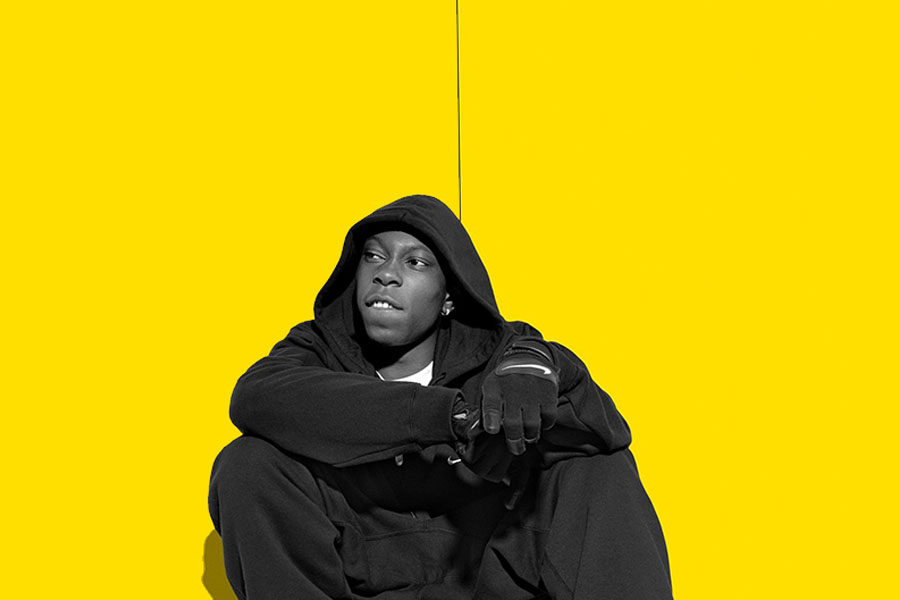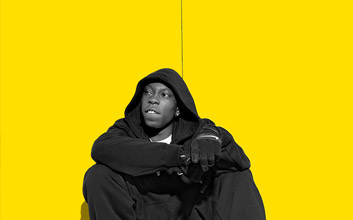Music is defined by the ways it makes you dance, and grime makes you jump. It pushes a beat through your body that shakes the ground. It sounds like unease and disorder. There’s something inherently aggressive in its rhythms.
It’s like what the horror movie genre is to cinema, without the grimace and gore; the complex craft of making you feel raw, uninterrupted emotion. It’s garage music with a story, that keeps people dancing. Grime was born out of the energy that is made when you’re dancing in a mosh pit.
Grime became grime with Dizzee Rascal’s Boy in Da Corner, and its ensuing critical reception, which pushed a sincere and ignored British experience out of the corner (or the underground) where it sat, separated from the polished pop scene of the time, and into the mainstream.

Dizzee’s Rascal’s Mercury Award-winning 2003 debut Boy In Da Corner brought the grime, emotion and vehemence of underground UK hip-hop into the mainstream.
Boy in the Da Corner was ‘grimy’ because it was an imprint of the streets; a portrait of East London and the council estate. But it was also grimy because it was so honest. It didn’t apologise for the streets; it didn’t glamorise or eulogise the experience; it didn’t condone the negative parts of estate life. It just reported on the world that a young boy saw each day; the bad and the worse, the emotions, the retribution, the debauchery.
Boy in Da Corner was coming of age paired with the coming of place. The lyrical invention of a place that had long existed, as seen through a teenager’s eyes.
How the Street Sounds from the Corner
Boy in Da Corner utilised garage-style beats, though Dizzee was clear to remove himself from garage music. In I LUV U, he raps, “I ain’t garage so get used to it”. In a retrospective interview with Complex Magazine, he describes garage or drum and bass as “too musical… I’m not classically trained. I couldn’t play any chords or nothing like that”. This distancing is important because garage, or any traditional genre for that matter, does not necessarily lend itself to the type of story Dizzee was trying to tell. The tracks he made had a heavy task in reflecting a specific, and unheard, experience. Who he was, where he came from, this particular moment in his life.
In telling his story, he emulated the emotions of the music that he liked. He matched garage music in its tempo, about 130-140 rpm, citing the dark garage of Musical Mob as a particularly pertinent influence, and replicated the sparseness and minimalism of its electronic language. He used elements of jungle or drum and bass, with its very low baseline frequencies, about 40Hz.
Dizzee also found a freedom in the regionalism of hip-hop and RnB, particularly that which was coming out of the American South. The force, and the high-pitched sound of his young voice, as well as the speed at which he had to rap over the tempo, speaks to a certain anger that forms the momentum of Grime, and it seems, of his youth.
Grime is often mused as music made for young people, by young people. When asked to describe Boy in Da Corner for a 2016 youth audience, he synopsises it as “really energetic… dark in a lot of places. A lot of it is like mosh music… It’s turn-up music.” In another retrospective interview, he notes, “It was mosh-pits that got me excited about music… That’s another reason why ‘Boy in Da Corner’ sounds the way that it does.” This accounts for the overall feeling of the album, that Dizzee was creating a particular energy, though it lacks credit for his narrative prowess.
In an interview with Red Bull Music Academy in 2016, the interviewee presses him on why he doesn’t make his own beats anymore, to which he responds, “You have to remember why I made beats in the first place. I made beats because I couldn’t get beats from nobody else. Who was I gonna get beats from?”.
Dizzee’s production techniques bode a kind-of ‘fake it till you make it’ mentality: “It was almost like you were pretending to be a big producer-slash-rapper”. With no reference point on this first album, he leaned heavily on the art he idolised for a structure. Many of the tracks were Dizzee doing his version of someone else. ‘‘I LUV U, that’s me doing Three 6 Mafia”. He describes the track as a cross between Is That Yo Chick? by Timberland and Jay Z, and Ludacris’s What’s Your Fantasy?. His love of Southern hip-hop is what he deems as his separation from UK garage. But unlike southern hip-hop, this music seemed futuristic.
Fix Up, Look Sharp samples the heavy rock beat of Billy Squier’s The Big Beat, also sampled in Here We Go by Run-DMC. In an interview with Fact Mag he says that, after hearing the song once, he started to write around the beat: “It wasn’t crazy to me because I was into heavy metal and rock and grunge before I was into hip-hop”.
The album is an ode to his streets, continually returning to the sounds of the city. In the opening track, Sitting Here, the sirens, skidding cars, and gunshots – sounds that are always jarring; it wakes you up. In Stop Dat, there are people yelling. In Hold Ya Mouf, the cocking of a rifle is used as a placeholder; sounds that place the listener on the sidewalk.
Writing Down Your Whole World
The first line of the first track, Sitting Here, identifies Dizzee as the objective observer watching the ‘same old story’ play out in different forms: “I’m just sitting here, I ain’t saying much I just think”. We understand already, that he is going write down the stories of his world, and, before even hearing the tracks, we know these aren’t the traditional stories of love or partying, found in pop music.
This is made clear in the phonetic spelling of track titles, and the album title itself. Using ‘da’ instead of ‘the’ in the album title proclaims that you are getting the story in this boy’s tongue. You don’t have to like it, and you don’t have to listen, but if you choose to do so, you will hear the raw, unmediated language of an East Londoner. He raps how he talks – a reason why rapping is inherently political. You can’t hide place, especially in London, where an accent is a ticket that tells everyone where you are sitting.
The stories include those of his own life. The personal – “I was raised around hate, not a hug not a kiss” (I LUV U). The ‘watch-what-happens’ foray – “I talk tough ‘cause life’s been rough/gritty, shitty life ain’t been too pretty, far from buff/ So I’m off to the elegant stuff” (Jus’ a Rascal). As well as the stories of his peers. Love is always tainted by depravity and being poor. Round We Go (Ain’t No Love) is a messed-up nursery-rhyme, which removes any of the innocence confounded with childhood: ‘one big cycle’ of playground gossip and relationships; mistaking love for lust; the heightened love of youth. Jezebel deplores this woman as a devil for sleeping around and manipulating men, but is inherently sad; more about lost youth, helplessness and regret than any one particular woman’s sexual record.
The themes of the album rest on cycles. Even if Dizzee didn’t yet understand the complexity of his place in the world, as a poor, black man, he is acutely aware that without this album, without his music, he was stuck, like so many of his peers, in a system that works against him. ‘Before this, I was just a failure in the mist’ (‘I LUV U’).
The Personal and the Cultural
There is a common thread in each of the interviews that Dizzee has done for this album, most of them are deeply retrospective. It’s difficult for him to articulate his process in making the album. What it comes back to, time and again, is that Boy in Da Corner was just a direct extension of himself and his experience. Something that he had carried around with him for a lifetime before he set it down on the track. It was every boy he had ever been. The 13-year old and the 16 year-old. They all met on one set. It was the child’s rendering of the world through a man’s eyes.
Like many of the best first-albums, Boy in Da Corner amalgamated the emotion of everything he had ever seen and heard. In the same interview with the Red Bull in 2016, Dizzee compared Boy in Da Corner to Nas’s Illimatic, in that it was both culturally important, and personally important.
The imprint of this 18-year-old slice-of-life was only possible because there was no industry interference: “There was no inhibitions, nothing to worry about because I was trying everything for the first time, experimenting and having fun,” he told Complex.
Nowhere is this clearer than in his reflection on winning the prestigious Mercury Award for the album. “I didn’t know what it was supposed to be… Who watched the Mercury Awards in the hood?” He told Red Bull. Yet, he was still an outsider. He won the Mercury Award, “went home to the estate, and passed it around”.
The release of the Boy in Da Corner and the award was the last bit of naivety he would have about the industry; about what fame means; about what grime would become. The album was made in faith only. It was a feeling; it wasn’t a genre. That’s why the grime scene today is better explained as a lifestyle than a category.
When people ask Dizzee to emulate this album in his new work, or even make something that resembles it, he tells them it is impossible. You cannot replicate 18-years of life. This album is simply a boy, watching the world go by, and writing down what he sees and feels.



